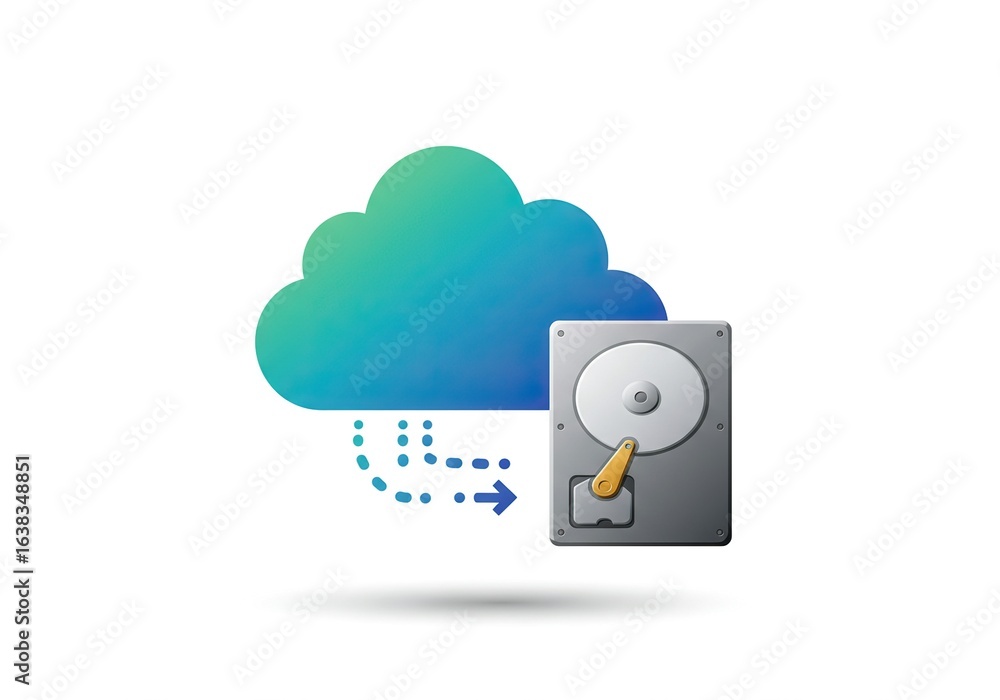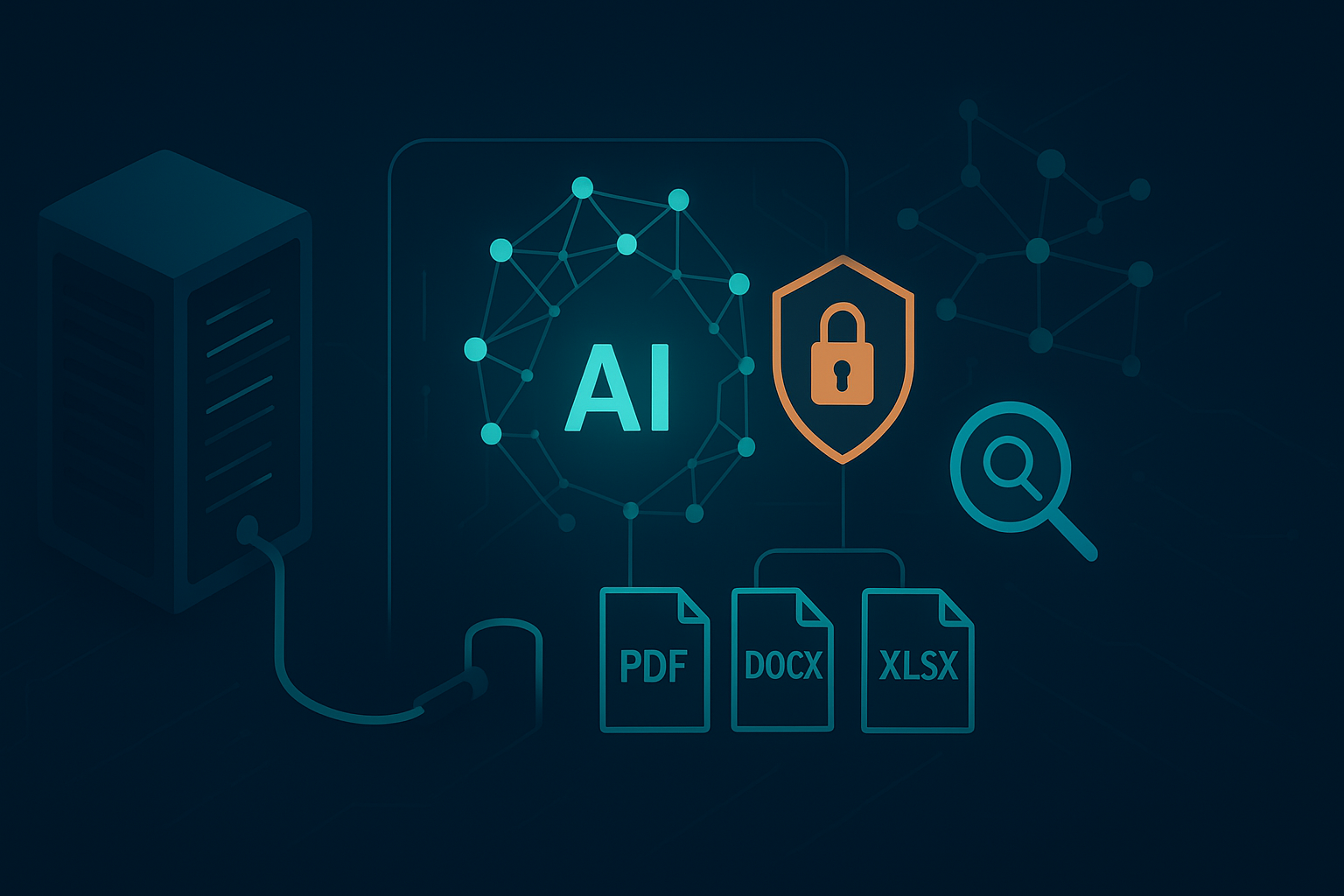What On-Premises AI Implementation Actually Involves
When organizations seek private AI deployment or self-hosted LLM solutions, they’re typically looking at implementing RAG (Retrieval-Augmented Generation) systems that can search and answer questions across large volumes of internal documents—PDFs, Office files, emails, and databases—while keeping all data processing within their own infrastructure. This guide covers enterprise AI consulting considerations for building these air-gapped AI systems.
A typical on-premise RAG implementation handles 1-5TB of documents, serves 100-1000 users, and processes natural language queries against proprietary data without cloud dependencies.

Technical Architecture for Private LLM Deployment
Core Components of Self-Hosted AI Systems
An enterprise knowledge management AI solution requires several integrated components:
- Document Processing Pipeline for On-Prem AI
- PDF parsing and OCR for scanned documents
- Office format handling (DOCX, XLSX, PPTX)
- Email processing (EML/MSG file conversion)
- Intelligent document chunking for RAG systems
- Hybrid Search Infrastructure for Private Deployment
- BM25 keyword search (Elasticsearch/OpenSearch)
- Vector similarity search using local embedding models
- Hybrid ranking algorithms for improved relevance
- Metadata filtering and faceted search capabilities
- Local LLM and AI Model Hosting
- Large Language Models (Llama, Mistral, Mixtral via Ollama)
- Embedding models (BGE, Nomic, Sentence-Transformers)
- GPU infrastructure planning for inference
- Model quantization strategies for resource optimization
- Storage Architecture for Enterprise AI
- Original document repository
- Processed chunk storage
- Vector embedding databases (Qdrant, Weaviate, pgvector)
- Search indexes and metadata stores
Scaling On-Premises AI from POC to Production
The transition from proof-of-concept to production private GPT implementation involves significant architectural changes:
Small-Scale On-Prem AI (10GB-100GB):
- Single-server deployment viable
- PostgreSQL with pgvector extension
- CPU-based inference acceptable
- Docker Compose orchestration
Enterprise-Scale Private AI (1TB-5TB):
- Distributed processing with Apache Spark or Dask
- Dedicated vector database cluster
- Multi-GPU inference infrastructure
- Kubernetes orchestration recommended
- Comprehensive backup and disaster recovery
Implementation Strategies for On-Premise RAG Systems
Option 1: Open-Source Self-Hosted AI Platforms
Popular Private AI Solutions: Danswer/Onyx, AnythingLLM, PrivateGPT, LocalGPT, h2oGPT
Implementation Process for Consultants:
- Docker containerization setup
- Network file system integration
- Local model configuration (Ollama integration)
- LDAP/Active Directory authentication
- Initial data ingestion and indexing
Typical Consulting Engagement Timeline:
- Week 1-2: Infrastructure setup and platform deployment
- Week 3-4: Data ingestion pipeline configuration
- Week 5-6: Model tuning and search optimization
- Week 7-8: User training and production rollout
Common Integration Challenges in On-Prem Deployments:
- Microsoft MSG file format conversion requirements
- Large Excel file processing timeouts
- OCR setup for scanned document archives
- Table extraction from complex PDFs
Option 2: Commercial On-Premises AI Solutions
Enterprise Vendors for Private AI: IBM Watson Discovery, Sinequa, Mindbreeze, Coveo On-Premises
Consultant’s Implementation Roadmap:
- Vendor assessment and RFP process (2-3 months)
- Infrastructure sizing and provisioning
- Professional services coordination
- Connector configuration for data sources
- Security and compliance validation
Budget Considerations for Enterprise AI:
- Licensing: $200K-2M annually
- Infrastructure: $100K-500K initial
- Professional services: $50K-200K
- Ongoing support: 20% annual maintenance
Option 3: Custom-Built Private LLM Solutions
Technology Stack for Self-Hosted RAG:
- Ingestion: Apache Unstructured, LlamaIndex, LangChain
- Search: OpenSearch + Qdrant/Weaviate
- LLM Serving: Ollama, vLLM, TGI (Text Generation Inference)
- API Layer: FastAPI, Django REST Framework
- Frontend: React, Streamlit, Gradio
Development Timeline for Custom On-Prem AI:
- Architecture design and POC: 4-6 weeks
- Core pipeline development: 8-12 weeks
- UI/UX implementation: 4-6 weeks
- Testing and optimization: 4-6 weeks
- Production deployment: 2-4 weeks
Critical Success Factors for On-Premises AI Consulting
Data Preparation for Private RAG Systems
Document Quality Assessment:
- Deduplication strategies for enterprise repositories
- Metadata extraction and enrichment
- Permission mapping from existing ACL systems
- Data classification for sensitive content
Infrastructure Requirements for Local AI Deployment
Minimum Production Specifications (1TB documents, 100 users):
- Processing nodes: 64-128GB RAM, 16+ CPU cores
- GPU infrastructure: 2-4x NVIDIA A6000/A100 (24-80GB VRAM)
- Vector database: 256GB RAM, NVMe storage
- Search cluster: 3-node minimum for high availability
- Storage: 10TB usable (RAID configuration)
Air-Gapped Deployment Considerations:
- Offline model repository setup
- Internal package mirrors (PyPI, Docker Hub)
- Closed-loop update mechanisms
- Compliance with classified network requirements
Security and Compliance in Enterprise AI
Access Control Implementation:
- Document-level permission inheritance
- Row-level security for database connections
- Audit logging for all queries and results
- PII/PHI detection and redaction pipelines
Compliance Framework Integration:
- GDPR data handling workflows
- HIPAA-compliant infrastructure
- SOC 2 audit trail requirements
- Industry-specific regulations (FINRA, ITAR)
ROI Metrics for On-Premise AI Implementations
Quantifiable Benefits for Enterprise Clients
Operational Efficiency Gains:
- Information retrieval time: 50-70% reduction
- Employee onboarding: 30-40% acceleration
- Compliance reporting: 40-60% faster
- Cross-department knowledge sharing: 3x improvement
Cost Avoidance Calculations:
- Reduced external research costs
- Decreased redundant work efforts
- Lower compliance violation risks
- Minimized intellectual property exposure
TCO Analysis for Private AI Systems
Three-Year Total Cost of Ownership (1TB, 200 users):
Open-Source Approach:
- Year 1: $200-300K (setup + infrastructure)
- Year 2-3: $100-150K annually (operations)
- Three-year TCO: $400-600K
Commercial Solution:
- Year 1: $400-700K (licenses + setup)
- Year 2-3: $250-400K annually
- Three-year TCO: $900K-1.5M
Custom Development:
- Year 1: $400-600K (development + infrastructure)
- Year 2-3: $150-200K annually (maintenance)
- Three-year TCO: $700K-1M
Best Practices for On-Premises AI Consulting Engagements
Project Scoping for Private LLM Implementations
- Data landscape assessment (file types, volumes, growth rate)
- Use case prioritization (search, Q&A, summarization, analysis)
- Integration requirements (SSO, data sources, existing systems)
- Compliance mapping (regulatory requirements, data governance)
- Success metrics definition (adoption, accuracy, time savings)
Phased Deployment Strategy for Enterprise AI
Phase 1: Pilot Program (Month 1-2)
- Single department or use case
- 5-10% of total data volume
- Core functionality validation
- User feedback collection
Phase 2: Controlled Expansion (Month 3-4)
- 2-3 departments
- 25-30% data volume
- Permission system implementation
- Performance optimization
Phase 3: Production Rollout (Month 5-6)
- Organization-wide deployment
- Full data ingestion
- Advanced features enablement
- Operational handoff
Change Management for AI Adoption
User Enablement Strategy:
- Executive sponsorship securing
- Champion user identification
- Hands-on training workshops
- Success story documentation
- Continuous improvement feedback loops
Vendor and Technology Selection Guide
Evaluation Criteria for On-Prem AI Solutions
Technical Requirements:
- Supported file formats and data sources
- Scalability limits and performance benchmarks
- Model flexibility and update paths
- API availability for custom integrations
Operational Considerations:
- Deployment complexity and prerequisites
- Maintenance and update procedures
- Monitoring and observability capabilities
- Backup and recovery mechanisms
Commercial Factors:
- Licensing models (per-user, per-GB, enterprise)
- Professional services availability
- Support SLAs and response times
- Total cost of ownership over 3-5 years
Common Pitfalls in Private AI Deployments
Technical Challenges
“The AI Doesn’t Understand Our Domain”
- Solution: Domain-specific fine-tuning or prompt engineering
- Implementation: Glossary injection, few-shot examples
“Search Results Are Irrelevant”
- Solution: Hybrid search tuning and reranking
- Implementation: BM25 weight adjustment, cross-encoder reranking
“System Is Too Slow for Production”
- Solution: Infrastructure optimization and caching
- Implementation: GPU scaling, result caching, index optimization
Organizational Obstacles
“Low User Adoption Despite Technical Success”
- Solution: Targeted use case focus and training
- Implementation: Department-specific workflows, success metrics tracking
“Data Quality Issues Surface Post-Deployment”
- Solution: Continuous data quality monitoring
- Implementation: Automated quality checks, user feedback integration
Future-Proofing On-Premises AI Implementations
Emerging Trends in Private AI
- Smaller, more efficient models (Phi, Gemma, Qwen)
- Multimodal capabilities (document + image understanding)
- Federated learning for distributed private training
- Homomorphic encryption for secure inference
Architectural Considerations for Longevity
- Modular design for component upgrades
- API-first architecture for flexibility
- Container orchestration for portability
- Model registry for version management
Conclusion: Delivering Successful On-Premise AI Projects
Implementing private AI and self-hosted LLM solutions requires balancing technical complexity with business value. Successful on-premises RAG deployments share common characteristics:
- Clear use case definition with measurable ROI
- Realistic timeline expectations (4-6 months to production)
- Adequate infrastructure investment
- Strong change management processes
- Continuous optimization mindset
For consultants specializing in enterprise AI implementation, the key differentiator is understanding that on-premises AI isn’t just about keeping data local—it’s about transforming proprietary knowledge into competitive advantage while maintaining complete control over security, compliance, and intellectual property.
Start with a Conversation
Not sure if on-premises AI is right for your organization? Let’s explore it together. Our initial consultation is free and includes:
- Discussion of your specific challenges and opportunities
- High-level feasibility assessment
- Overview of potential approaches
- Rough timeline and investment estimates
- Clear next steps (even if that’s “do nothing”)
No pressure. No sales pitch. Just honest guidance.
Contact OliveTech
? Email: todd@olivetech.co
? Phone: 970-430-5877
What to Expect:
- 30-minute discovery call to understand your situation
- Follow-up with preliminary thoughts (no charge)
- Proposal for assessment if there’s mutual fit
- Clear decision framework whether you work with us or not
